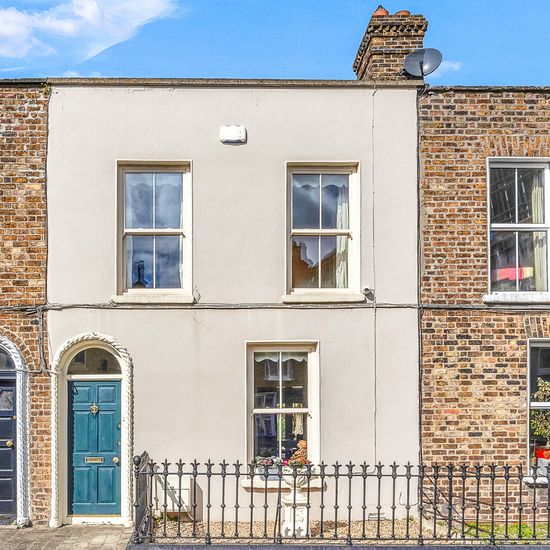Copyright independent

Asking price: €925, 000 Agent: Owen Reilly (087) 9073611 In Britain, family names like Baker, Cooper, Smith, Butcher and Carpenter are a reminder that professions were passed down through the same families; for so many generations, that those professions defined the name of that family. Smith, for example, is a common name because so many of them were needed back in times when everything ran on horsepower. Here in Ireland, professions were also handed down through families, although the profession never became the family name. Fathers trained the male children from a young age, usually about 11, and brought them to work as an assistant in order to apprentice the family trade. In 1901, carpenter William Osborne (aged 43) was living at 21 Albert Place East at Grand Canal Dock in Dublin 2, at a time when Dublin Port was a hive of activity and employment. With plenty of work about, it’s not surprising that he could afford a better home than most. Built in the 1890s, the cul de sac of terraced houses was mostly popular with former British army officers, civil servants and those in senior servant positions at some of the larger homes on nearby Merrion Square. Osborne shared the two-bedroom late-Victorian home with his wife Julia (40) and their three children. She, like most women of the time didn’t work, although tellingly both his teenage sons George (18) and John (15) are listed as carpenters while daughter Mary (12) is a ‘scholar’. The family are still residing here at the time of the next census in 1911, by which period William had risen to the ranks of builder’s foreman and George had become a clerk of works teacher of building and construction. John was still working as a carpenter. While they had a craft, the Osbornes were also crafty by nature. Because 10 years later in 1911 George has somehow aged 12 years (he is listed this time as being 55) and Julia has miraculously aged 14 years (she is listed as being 54). The answer to this conundrum is likely the fact that that in 1909 between the two censuses, the old age pension was introduced for those over 70. By ageing 12 years in 10, William could claim his at 68 while Julia, by ageing 14 years in a decade, could claim hers at 66, akin to modern day pension age. The now 1,130 sq ft period home was bought in 1978 by the parents of web developer Alan O’Reilly who now lives in Rathmines. His father, Gerard O’Reilly worked in the telecoms industry and had grown up four doors down from No21, and at the time his grandmother was still living there. Alan was born in the house and grew up there. “It was a happy childhood,” he recalls. “I loved living in the city centre. It meant I could walk everywhere. I never learnt to drive,” he adds. “I used to walk to school, walk to college, and walk to work.” The interior of No21 was in need of an upgrade when the O’Reillys bought it. “It was gutted in 1990,” he says. “An extension was added at the back; the walls were re-painted; and new wooden floors were installed.” The attic was also insulated 10 years ago, increasing the BER rating to a very decent B3, and in recent years new units by Kube were installed in the kitchen, granite counter tops were added and the floor was tiled in beige. Although now billed as a two -bedroom house, it actually has three, but one has no side windows, with a skylight in the roof, and therefore does not officially qualify as one. It would, however, make a decent home office. The master bedroom is a light-filled room with built-in wardrobes along one wall and two south-facing windows. The Victorian-style archway above the stairwell is worth a mention, and there are two original cast-iron Victorian fireplaces in the two reception rooms. These flow into each other and, divided by sliding doors, lead to the kitchen at the back. “When all of the doors are pulled back, it creates it big space that runs the length of the house, which is perfect for entertaining,” he says. “My mother had many relations and they’d always stay with us. It was an open, welcoming house.” Now deceased, Nuala O’Reilly made all the decisions about the interior, opting to paint the walls pristine white, and adding mostly white furniture, giving it an open, airy feel. “She was interested in antiques and anyone who visited used to comment on them,” says Alan. In the front room, the ceiling has a mock ceiling rose and a long carpet on top of the polished wooden floor. There’s a mirror above the fireplace, adding to the feeling of space and a piano, belonging to his mother. “It was a house that was filled with music when I was growing up,” says Alan, who plays the violin himself. “She was a musical person. She played the piano and also the ukulele. In fact, she was a member of the Dublin Ukulele Collective which performed at Electric Picnic on a number of occasions.” His mother would often sit in the long west-facing back garden, which is accessed by French doors from the kitchen, and play the ukulele. It was landscaped at the same time as the interior and has been paved. There’s a patio here with garden furniture, a garden shed at the back, flower beds with shrubbery, hanging plants on the walls, and a mature palm tree. It opens to a communal laneway, which provides rear access and resident permit parking is available to the front. Located near Grand Canal Dock, today known as the Silicon Docks because of the presence of big employers like Google and Meta, it’s around the corner from Merrion Square. These days, the street has an eclectic mix of residents, including third-generation tenants, business people, artists and barristers. Having grown up in the house, Alan knows most of them. “There’s a strong sense of community in the area which is unusual for the city centre. Everyone helps each other out.” Despite the happy memories he has of growing up there, Alan is selling it following the recent passing of his brother. “It’s difficult for me because I’m clearing a lifetime of memories out of the house at the moment, but I think my mother would be keen for the house to be put to use,” he says. “She wouldn’t like it to be left sitting there empty. It feels like selling it is the right thing to do.” Owen Reilly seeks €925,000.



